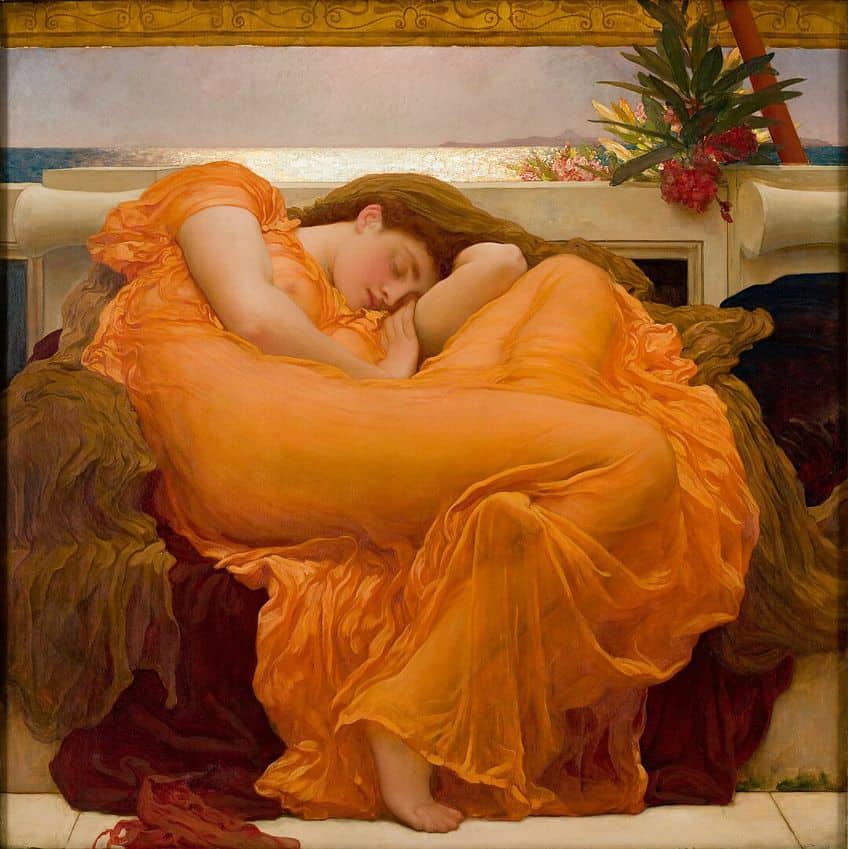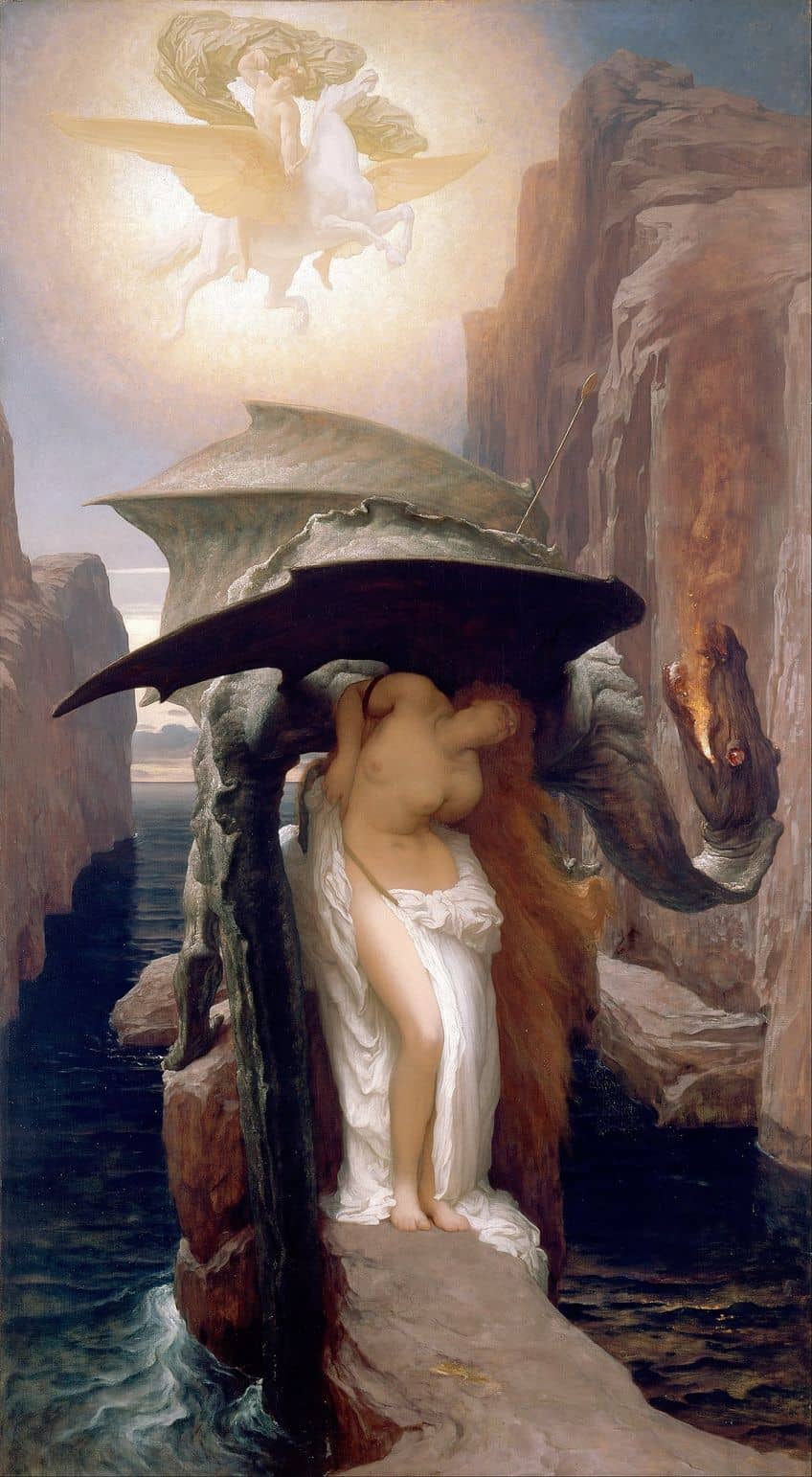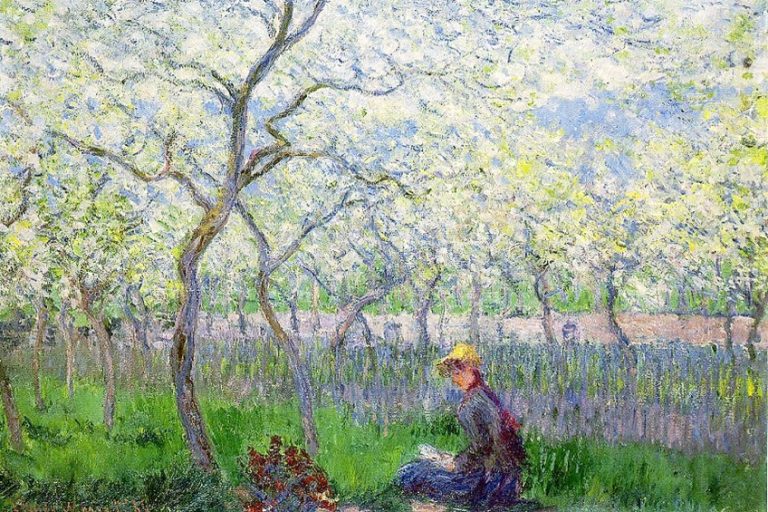“Flaming June” by Frederic Leighton – A Formal Analysis
In the realm of Victorian art, Frederic Leighton’s Flaming June stands as a beacon of beauty and tranquility. Painted in 1895, this masterpiece encapsulates the essence of aestheticism with its vibrant colors and serene composition. Despite its apparent simplicity, Flaming June beckons viewers to explore its layers of meaning and symbolism, reflecting the socio-cultural context of the late 19th century. Join us as we embark on a voyage of discovery, unraveling the mysteries and marvels of Frederic Leighton’s work and uncovering the timeless beauty that continues to resonate with audiences across the globe.
Table of Contents
Key Takeaways
- Flaming June epitomizes Victorian classical aesthetics through Leighton’s celebrated craftsmanship.
- The painting’s rediscovery enkindled a renewed appreciation for late Victorian artwork.
- Its legacy endures as a quintessential representation of 19th-century art, reflecting the period’s cultural values.
Historical Context
| Artist | Frederic Leighton (1830 – 1896) |
| Date Created | 1895 |
| Medium | Oil on canvas |
| Genre | Romanticism, Aestheticism |
| Period/Movement | Victorian Era, late 19th century |
| Dimensions (cm) | 120 x 120 |
| Series/Versions | Single version, no known series |
| Where Is It Housed? | Museo de Arte de Ponce, Puerto Rico |
| What It Is Worth | Estimated value ranges from $5 million to $50 million |
Frederic Leighton’s Flaming June emerged during the Victorian Era, encapsulating the essence of Aestheticism. Renowned for his contributions to the art world, Lord Leighton secured a prestigious position within the British art scene with prowess and sophistication.
Sir Frederic Leighton, a dominating figure in the British Artist community, crafted Flaming June with intimate knowledge of the Victorian Era’s artistic preferences.

Design and Inspiration
As an emblematic masterpiece of the Aestheticism movement, the painting reflects a dedication to beauty and sensory experiences unburdened by moral or political themes. Leighton skillfully interweaves classical influences, evident in the choice of subject matter and composition—echoes of Greek art are palpable in the serene, dreamlike posture of the dozing woman.

Presented at the Royal Academy of Arts in 1895, Flaming June was one of six pieces marking Leighton’s last submissions to the institution. His stature as president of the Academy is evidenced in his technical expertise and the warm reception of his work, which were both testaments to his role in shaping fine arts during the period.
Flaming June remains a quintessential reflection of Lord Leighton’s legacy in the canon of art history.
Formal Analysis
In analyzing Flaming June by Frederic Leighton, a focus on its vibrant color palette, thematic subject matter, technical execution, and embedded symbolism reveals the nuanced complexity of this 1895 masterpiece.

Use of Vivid Color
Flaming June is renowned for its distinct use of color, particularly the luminous shade of orange that encompasses the central figure’s drapery. The painting’s harmonious color scheme enhances the warmth and glow of the Mediterranean setting, which is juxtaposed with the cool blue of the sea in the background.
This has the effect of amplifying the overall visual impact.

Subject Matter of the Artwork
The artwork’s subject is a sleeping woman, depicted in a state of peaceful sensuality that reflects the ideals of Neoclassicism and the influence of the Greek tradition. The figure’s pose and the serene setting allude to the languid warmth of a Mediterranean afternoon.
The sleeping state suggests an escape from reality, evoking a dream-like atmosphere.

Techniques and Materials
Leighton utilized oil on a square canvas to bring Flaming June to life, measuring notably 47 inches by 47 inches. His techniques reflect the refined brushwork of the Renaissance, a period during which masters like Michelangelo heralded the importance of form and composition.
Leighton’s skillful blending and layering of oil paints create a tactile quality in the woman’s flowing dress and soft skin.

Symbolism and Narrative
Symbolism within the painting is rich, with the inclusion of oleander flowers, which hold a dual representation of both beauty and danger, as the plant is toxic. Furthermore, the sweeping curves and posture of the figure draw a connection to the sensuous forms seen in Renaissance art.
The narrative of Flaming June remains largely interpretative, with the themes of beauty, sensuality, tranquility, and a subtle hint of mortality woven into its visual fabric.

Provenance and Rediscovery
This section uncovers the journey of Frederic Leighton’s Flaming June from its initial reception to its eventual rediscovery, underscoring its movement through various institutions and hands. When Flaming June was first exhibited by the British artist Frederic Leighton in 1895 at the Royal Academy of Arts in London, it was met with acclaim. Critics considered it one of Leighton’s finest works.
Despite the positive critical reception, its whereabouts became uncertain after Leighton’s death.
Loss and Rediscovery
The painting resurfaced when it was rediscovered and subsequently purchased by Luis A. Ferré, the founder of the Museo de Arte de Ponce in Ponce, Puerto Rico. Flaming June had fallen into obscurity, but Ferré’s acquisition brought it back into the public eye. It has since been loaned to several prestigious institutions, including The Frick Collection in New York, and featured in exhibitions that traced its history, such as a significant display at the Leighton House Museum in England.

Legacy and Impact
Frederic Leighton’s Flaming June has carved an indelible mark on Western art, bridging the gap between traditional Victorian artistic values and the evolving preferences of modern aesthetics. This Victorian masterpiece, created in 1895, holds an influential role in the narrative of Western art. Its influence extends beyond the canvas, inspiring contemporary artists who draw upon Leighton’s technique and composition. The iconic work, often featuring the image of a sleeping beauty, has become a symbol of the Aesthetic Movement’s ideals.
Leighton’s attention to form, color, and emotional subtlety continues to resonate with modern creators, echoing the refined classicism that Leighton championed.
Cultural Significance
Beyond its artistic acclaim, Flaming June remains a cultural phenomenon. At one point forgotten and rediscovered, much like a “tired model” revived, the piece has maintained a lasting presence. Notably, it found a permanent home thanks to the Luis A. Ferré Foundation, ensuring its public exhibition and influence. As the visual embodiment of serenity and the epitome of Leighton’s artistic companions, such as Dorothy Dene and Mary Lloyd, the piece stands as a cultural touchstone. Its reproduction in the 21st century, from posters to digital media, underlines its cultural significance and pervasive impact. The journey of Flaming June—from the estate of Samuel Courtauld to its status as an iconic representation in art—exemplifies the enduring legacy and public magnetism of this work.

Flaming June by Frederic Leighton epitomizes Victorian artistry and reflects the era’s aesthetic ideals. Its masterful use of color, composition, and symbolism transports viewers into a realm of tranquility and introspection. Leighton’s work not only showcases his technical skill but also speaks to the enduring ability of art to captivate and inspire across generations. As we delve into its mysteries, Flaming June reminds us of the profound impact art can have in stirring the soul and igniting the imagination. Today, the painting stands not only as Leighton’s most recognized work but also as a symbol of Victorian art’s enduring legacy.
Frequently Asked Questions
What Is the Estimated Value of Flaming June?
Flaming June is not only a pinnacle of Sir Frederic Leighton’s work but is also considered one of the most recognized pieces of 19th-century art. Its exact value is not publicly disclosed, but as a highly celebrated artwork, it would likely fetch a significant sum if it ever came to auction.
What Does the Painting Symbolize?
The painting is often interpreted as a symbol of the serene, resting state, possibly embodying the warmth and vitality of the Mediterranean sun and climate. It encapsulates the pinnacle of the Victorian era’s artistic expression and the Aesthetic movement’s dedication to beauty.
Who Served as the Model for Flaming June?
The specific identity of the model for Flaming June remains unknown. Leighton is known to have been inspired by classical Greek art and aesthetics, which he may have incorporated into his interpretation of the figure’s pose and the painting’s composition.
Isabella studied at the University of Cape Town in South Africa and graduated with a Bachelor of Arts majoring in English Literature & Language and Psychology. Throughout her undergraduate years, she took Art History as an additional subject and absolutely loved it. Building on from her art history knowledge that began in high school, art has always been a particular area of fascination for her. From learning about artworks previously unknown to her, or sharpening her existing understanding of specific works, the ability to continue learning within this interesting sphere excites her greatly.
Her focal points of interest in art history encompass profiling specific artists and art movements, as it is these areas where she is able to really dig deep into the rich narrative of the art world. Additionally, she particularly enjoys exploring the different artistic styles of the 20th century, as well as the important impact that female artists have had on the development of art history.
Learn more about Isabella Meyer and the Art in Context Team.
Cite this Article
Isabella, Meyer, ““Flaming June” by Frederic Leighton – A Formal Analysis.” Art in Context. February 12, 2024. URL: https://artincontext.org/flaming-june-by-frederic-leighton/
Meyer, I. (2024, 12 February). “Flaming June” by Frederic Leighton – A Formal Analysis. Art in Context. https://artincontext.org/flaming-june-by-frederic-leighton/
Meyer, Isabella. ““Flaming June” by Frederic Leighton – A Formal Analysis.” Art in Context, February 12, 2024. https://artincontext.org/flaming-june-by-frederic-leighton/.











